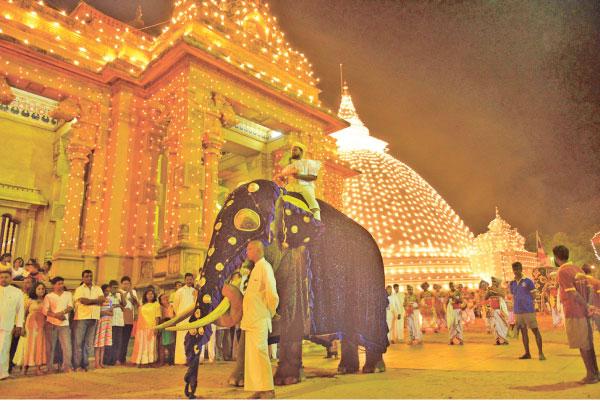
The history of Kelaniya goes back into pre historic times and it is also linked to the Ramayanaya. Vibishana , brother of Lanka’s demon king is said to have been here and legend has it that Prince Rama of India befriended him. It is also recorded that Lakshmana, Rama’s brother crowned Vibishana at Kelaniya.
The Kelaniya Temple is sacred to Buddhists and its recorded history dates back to the time of the Gautama Buddha. The Buddha’s third and final visit to Sri Lanka was made to Kelaniya at the invitation of the Naga (cobra) King Maniakkhika.
The Buddha who made this visit eight years after he attained Enlightment or Buddhahood had been accompanied by 500 Arahaths. (The Buddha preached the Dhamma seated on a jewel studded chair and King Maniakkhika built a stupa enshrining the jewelled throne.
According to the Chulavamsa, the ancient temple was five-stories high and had traditional roofing. The temple has been renovated several times and Prince Uttiya (brother of King Devanampiyatissa) is supposed to be the first person who had renovated the temple and he is also beleievd to have built the Sanghawasa (residential hall for bhikkhus).
Dravidian invaders destroyed the Kelaniya Temple several times and it was restored by Sinhala Monarchs. King Vijabahu the Third and King Parakramabahu the Second were two such monarchs.
In 1575, a Portuguese captain, Diogo de Melo destroyed the Kelaniya temple. Once the Dutch conquered Sri Lanka’s maritime provinces they relaxed the strict rules and King Kirthi Sri Rajasinghe, the Sinhala King in Kandy renovated the temple in 1767.
The Kelaniya temple as it is today was renovated in the late 19th century by a Sinhala woman philanthropist, Helena Wijewardena. She also commissioned artist Solius Mendis to paint murals.
He did murals. They depict events from the life of the Buddha, the destruction of the temple by the Portuguese among other subjects.
The Upper Terrace has the Image House, the Dagoba and the Bo tree.
Duruthu Perehera
The Poya day in January is called the Duruthu Poya and on this day the Duruthu Perahera of the Kelaniya Temple parades the streets. This was started in 1927 by Don Walter Wijewardena, Helena Wijewardene’s son. Preparations start 72 days earlier with Dhammadesanas and Sunday Schoolchildren going in proceesion round the Uda Maluwa and a Bodhi pooja will be offered by an adult.
The Deva Dutha perehera is held before the three Duruthu peraheras. At the end of the Deva Dutha perahera, a young boy dressesd as a Deva Duthaya will recite the Doraka da Asna invoking the blessings of the God on the perahera. The procession commences with the Viharadhipathi (Chief Incumbent) handing over the casket containing the sacred hair relic to the Chief Basnayake Nilame (Lay Custodian) to be placed on the gaily caparisoned tusker who will carry it in the procession.
Whip crackers, drummers and dancers of up country and low country, stilt walkers, fire ball dancers and many other artistes will particiapte in this spectacular procession. There will be many gaily caparisoned elephants and the Gajanayake Nilame is the one in charge of the elephants.
The Peramune Rala (in charge of the perahera) will be astride an elephant at the head of the procession. The Randholi Perahera will be joined by the three Devala peraheras. These three devala’s are dedicated to the deities, Kataragama, Vishnu and Vibhishana.
There are two smaller peraheras or processions on the two days before the Randoli or main procession. The first is round the Uda Maluwa and the second is round the Pahala Maluwa.
